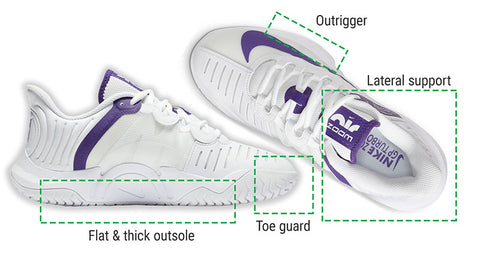Footwear is one of the most important pieces of equipment for any sport. The right shoe can provide comfort, support, and even help prevent injuries.
A common question we receive is “Why can’t I wear a running shoe?” Running shoes are designed for continuous forward motion. The outsole of a running shoe is typically flexible for this reason. On the other hands, tennis shoes are intended for quick and short forward, backward and side-to-side (lateral) movements. Although the two sports resemble one another, they have entirely different movements. A hockey player would not wear figure skates on the ice, just as a tennis player would not wear a running shoe on the court.
Each tennis shoe contains four unique elements:
- Lateral support
- Outrigger
- Toe guard
- Flat and thick outsoles

Lateral Support
Tennis shoes are built from heavier and larger materials, focusing on the midfoot region. This provides lateral, side-to-side support to prevent ankle rolling among other knee and hip issues. Many find this type of material to be too rigid compared to what they are accustomed to. It is important to remember that the heavier and firmer a tennis shoe feels, the more stability it likely provides.
Outrigger
To optimize side-to-side movements, there’s an outrigger placed on the outside of the shoe. This provides greater foot stability for easier and quicker lateral movements.
Toe Guard
With quick stop and go movements, certain areas of the shoe are more prone to wear and tear. For example, the toe area typically takes most of the force with each direction change. Some players destroy the toe area while serving; therefore, reinforced toe guards are in place to ensure durability with each push off, toe drag or sudden stop.
Outsole
Compared to running shoes, tennis outsoles are flat in order for greater energy transfer and ease of motion. The outsoles are also typically thicker for more durability. Certain outsole treads are designed for specific court surfaces. Each tread-type provides the best traction and durability based on the conditions. For example, if you play on a clay or hard-tru court, you would need a tennis shoe with a full herringbone tread.
Fore more information on this, please read: Why Court Surface Matters
Bottom Line:
Tennis shoes are an essential piece of equipment for players featuring lateral support, outriggers, toe guards and flat, thick outsoles. These unique elements ensure durability, comfort, support, as well as aiding in injury prevention.
Our collection of tennis shoes can meet any and all of your tennis court needs. Please feel free to check out our Men's Tennis Footwear, Women's Tennis Footwear, Junior Tennis Footwear or All Footwear for more selections.






